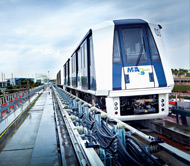
Global Solutions For Business
Linking Expertise and Resources
Diverse and Extensive Market Reach
Our Fourth U.S. APM Project Transports Passengers to New MIA Rental Car Facility Sumitomo Corporation of America’s Transportation
Department is helping get Miami International Airport (MIA) passengers from the runway to the roadway faster than ever before. The MIA Mover, a 1.25-mile-long automated people mover (APM) system between MIA and the new Rental Car Center, opened to the public on September 9. This marks the second APM system at Miami International Airport completed by SCOA and Mitsubishi Heavy Industries America (MHIA), and the fourth APM system that this duo has ushered into use in the U.S. in the past four years.
SCOA increased its presence in the APM arena by spearheading the completion of four operating APM systems in the U.S.: the new Miami International Airport rental car facility system, the current MIA APM system at the NorthTerminal, theWashington-Dulles International Airport system, and the Atlanta Hartsfield-Jackson International Airport CONRACMA CHINERY AND POWER system. All four of these APM systems consist of MHIA’s cutting-edge Automated Crystal Mover vehicles,which are equipped with rubber tires to reduce noise and increase passenger comfort. Sumitomo.
Corporation, together with Mitsubishi Heavy Industries (MHI), has successfully installed APM systems at several major airports worldwide including Singapore, Japan,Hong Kong and Korea. APMs are currently helping passengers and relieving congestion in airports in Madrid, Beijing, Bangkok,Toronto, and talks are currently underway to establish APM technology in Navi Mumbai International Airport in New Delhi, India.
 On September 8, SCOA personnel joined over 200 business and community leaders along with officials from Miami-Dade County, the Greater Miami Convention and Visitors Bureau, Parsons-Odebrecht Joint Venture, and MHI for an inaugural celebration and preview of the MIA Mover before its public opening on September 9.
On September 8, SCOA personnel joined over 200 business and community leaders along with officials from Miami-Dade County, the Greater Miami Convention and Visitors Bureau, Parsons-Odebrecht Joint Venture, and MHI for an inaugural celebration and preview of the MIA Mover before its public opening on September 9.
“The success of this project is primarily an example of cooperation between multiple contractors with one common goal,” said Gino Antoniello, SCOA’s Vice President of Transportation Systems,“which is to provide a state of the art transit system on time and on budget, and this latest accomplishment continues to demonstrate Sumitomo’s capability, know-how and commitment to the marketplace.
” With a top speed of 40 miles per hour, the MIA Mover has the capacity to transport more than 3,000 passengers per hour directly between MIA and the Rental Car Center’s customer service lobby just east of Le Jeune Road. MIA passengers simply exit their concourse and take elevators to MIA’s third level moving walkway, which quickly connects them to the MIA Mover.
Construction began in March 2009 and was completed within a budget of $270 million,with $170 million from the Miami-Dade Aviation Department’s Capital Improvement Program and $100 million from the Florida Department of Transportation (FDOT).
The MIA Mover completely replaces the Rental Car Center shuttle bus service previously in operation, eliminating approximately 1,400 shuttle bus trips per day and reducing carbon emissions from MIA’s roadways by 30 percent. The MIA Mover’s MIA Station is also the first mass transit project in Miami-Dade County to receive Gold LEED (Leadership in Energy and Environmental Design) certification by the U.S.Green Building Council. The Rental Car Center, a 3.4-million-square-foot, four-level facility that houses 16 major rental car companies, serves an average of 16,000 airport customers daily.
“The MIA Mover is yet another successful milestone for Miami–Dade County,MIA, POJV, and its partners,” said José Abreu,Director of the Miami-Dade Aviation Department. “The movement of people is what we are all about, and today we are even closer to the day when the traveling public can move seamlessly among all forms of ground transportation, mass transit and air travel.”
A secondary but important benefit of the system is the reduction in vehicle traffic at the terminals,which is expected to significantly reduce exhaust fumes near passenger entrances and walkways.
“To address airport space considerations and to relieve the congestion that thousands of cars per hour bring,”Antoniello added,“the APM system displaces a significant amount of airport traffic,making operations smoother and more secure.”